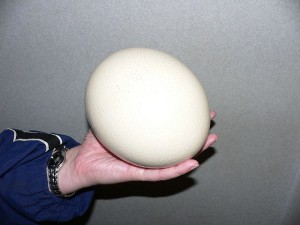This section was contributed by Dr Beatrice Demarchi at the University of York.
Introduction to amino acid racemisation (AAR)

Amino acid geochronology is a relative dating technique able to span the whole Quaternary. It can be applied to a range of common materials which are directly related to the human occupation of an archaeological site, for example mollusc shells and ostrich eggshells. These are also preserved in sediments which accumulated as a response to global climatic pulses, during the Pleistocene and beyond. Therefore, amino acid geochronology has the potential to be widely applicable to the chronology of human evolution, as well as to the geological record.
Racemisation
Racemisation it is a post-mortem spontaneous reaction, involving the interconversion between two different forms of a single amino acid, the D- and L-forms (these are chemically identical but differ in the spatial configuration of their atoms). L-amino acids are present in living organisms, while D-amino acids are formed post-mortem by racemisation. The extent of racemisation can be measured by the ratio between the concentrations of D- and L-forms detected in a fossil sample: this is called D/L value. The D/L value yields an estimate of the time elapsed since the death of the organism: older fossils will have higher D/L values (closer to 1) (see Fig. 1).

However, for the use of amino acid racemisation (AAR) as a reliable dating tool, analysis of proteins from a closed system within fossils is vital. This is achieved by chemical isolation of a fraction of proteins (intracrystalline) which behave as a closed system during diagenesis. The extent of protein degradation within this closed system yields an estimate of the age since death of the organism. The intra-crystalline fraction within ostrich eggshell1, and from terrestrial and marine molluscs2,3 have been found to allow significant increases in the resolution and reliability of AAR geochronology.
Applying amino acid racemisation as a dating tool

The amino acid racemisation method has been applied to widely different environments: shell middens4, raises beaches5, fluvial terraces in Northern Europe6, but also in the Mediterranean rim, i.e. famous cave sites such as those in Southern Spain, Italy and Libya, and the early modern human sites at Pinnacle Point, South Africa (details on the Pinnacle Point project).
For each of these geographic areas, chronological frameworks have to be built independently: racemisation is a temperature-sensitive reaction, and it will proceed at different rates (speeds) if the organism is buried in a cold cave in Scotland or in the sands of the Sahara desert. This has an effect on a) the level of temporal resolution (which will be higher in warmer climates, because racemisation is fast) and b) the time span of the technique (which will be wider in cold areas, because a D/L value = 1 is reached more slowly). For Antarctica, AAR dating would be an important source of relative age information for shell-bearing sediments spanning the whole of the Pleistocene and due to the cold conditions its range could be extended much beyond its current limit.
Go to top or jump to Optically Stimulated Luminescence.
